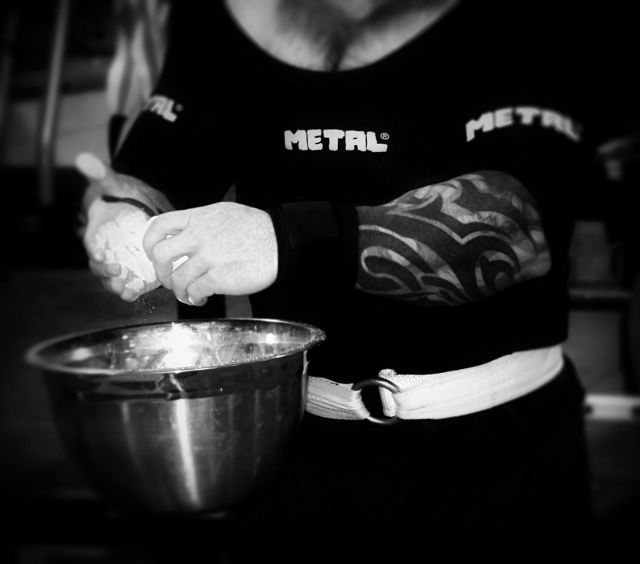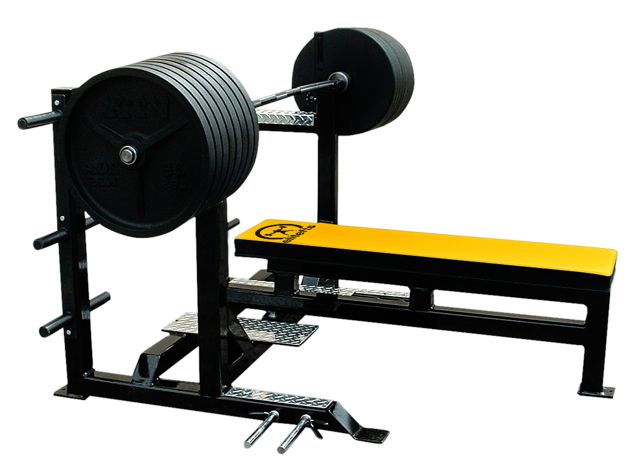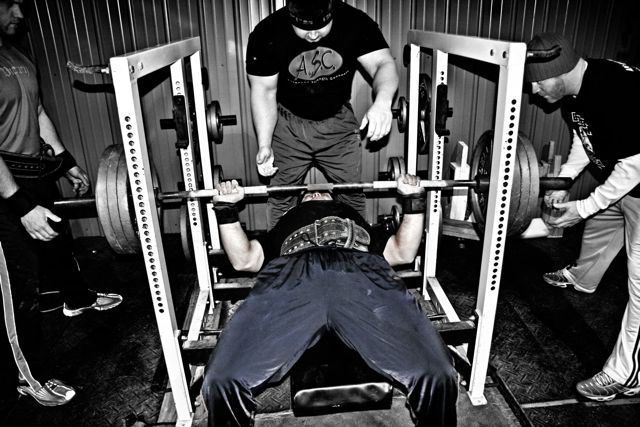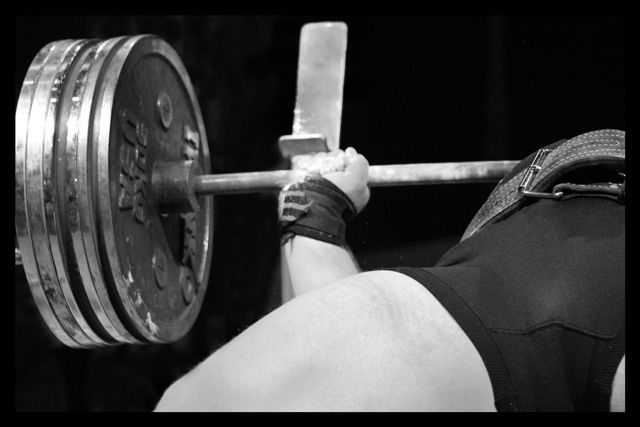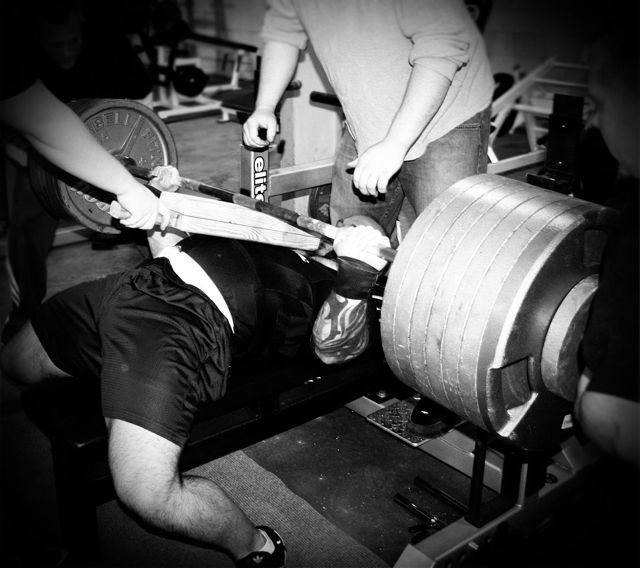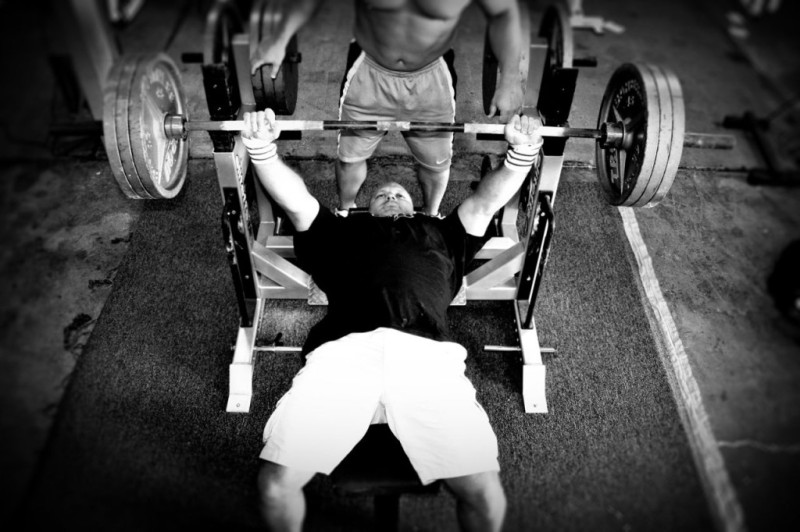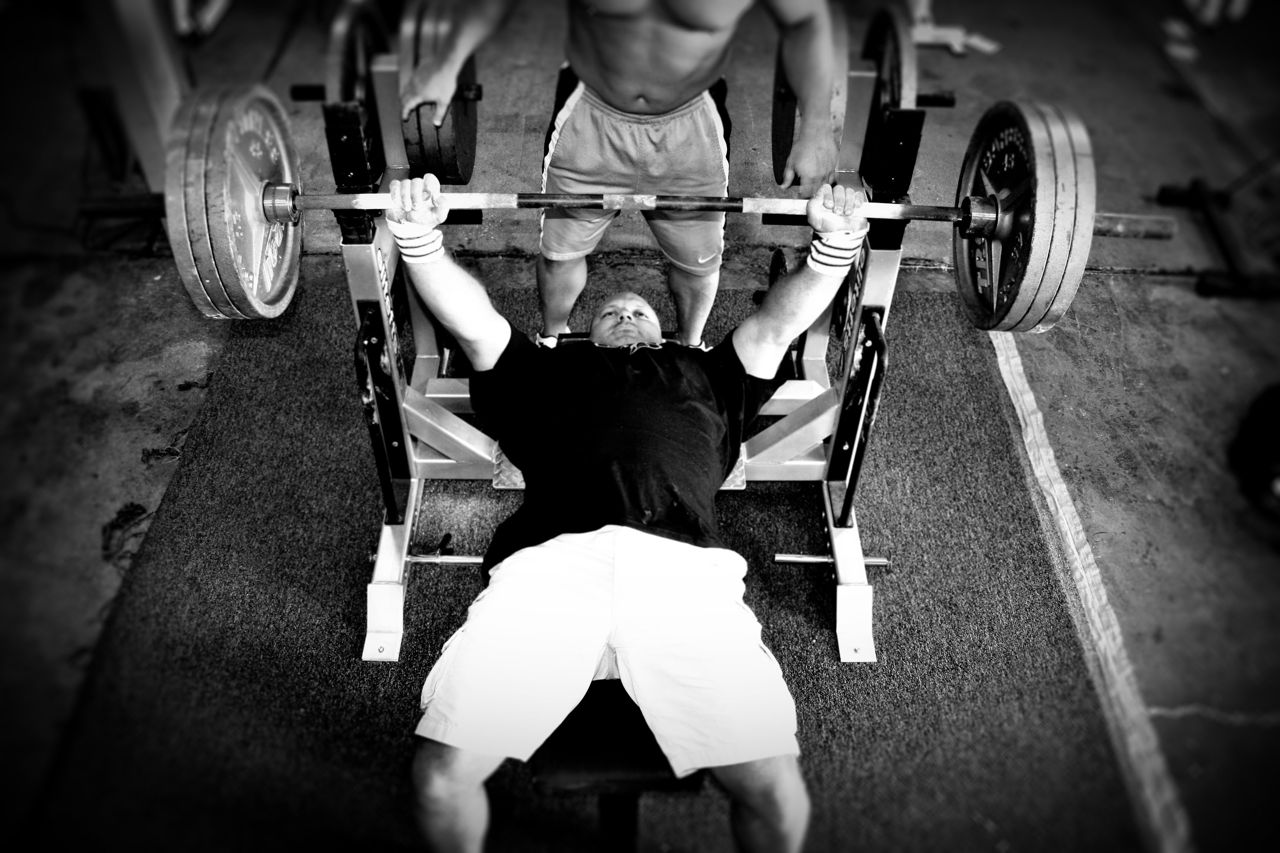
This elitefts™ Classic was first published July 07, 2000 on T-muscle.com
I spend most of my weekends in transit these days. In fact, I'm writing this article on a plane headed to yet another seminar I'm conducting. This travel time gives me the chance to think, relax, and reflect on many issues dealing with training and life. I also use the time to prepare for my upcoming seminar or consulting session. I normally sit here going over what topics I'll be presenting and how I can better relate them to my audience. But today there's a problem. No there's not a creature on the wing throwing monkey wrenches into the plane's engines, but it's almost that bad. The problem is all I can think about is my bench press!
You see, I train at WSBB, which is renowned for producing world-caliber strength athletes. I've been a part of this group since 1990. Before that, I had spent five years stuck at a 1955 pound total in powerlifting. Then I tore my right pectoralis major tendon while trying to bench 500 at a bench press competition. I figured that was the end of competition days and thought about retiring from the sport. Then I thought to myself, retire from what? I haven't done anything yet!
I knew I had two options: I could keep training the way I always had and totally fall apart, or I could move to Columbus to train under the watchful eye of Louie. It wasn't that difficult of a decision. After the surgery I packed the car and moved to Columbus. That was over ten years ago. Since then, my lifts have increased to a 935-pound squat, 585-pound bench and a 740-pound deadlift. This was after my surgeon told me I'd never bench over 400 again!
Although my bench press has increased 85 pounds, it's still a far cry from where it should be. At Westside we have 34 guys benching over 500 pounds and eight benching over 600. (In fact, six of those eight guys press over 650!) My bench pretty much sucks when compared to the others in the gym. When people ask me for bench advice, I cringe because I'm still chasing 600. I've missed that mark five times in competition at the time of this writing.
I kept telling myself that once I push up 600 pounds I'd write a definitive article on benching. Well, I haven't hit that mark yet, but I do have the biggest bench out of everyone on my flight, so I'm feeling like an authority on benching at the moment. Who knows, maybe writing this article I'll teach myself something, or remember something I've forgotten? I also feel the need to write this because of the vast amount of misinformation out there on this subject. I feel there're 12 components to a great bench press. If we apply these 12 steps, then perhaps you and I both will reach our bench press goals.
12 Steps to a Bigger Bench
1 — Train the Triceps
Years ago, if you had asked Larry Pacifico how to get a big bench, he'd have told you to train the triceps. This same advice applies today. This doesn't mean doing set after set of pushdowns, kickbacks, and other so-called "shaping" exercises. Training your triceps for a big bench has to involve heavy extensions and close-grip pressing movements such as close-grip flat and incline bench presses, close-grip board presses, and JM presses.
Various barbell and dumbbell extensions should also be staples of your training program. Don't let anyone try to tell you the bench press is about pec strength. These people don't know the correct way to bench and are setting you up for a short pressing career with sub-par weights. I just read an article in one of the major muscle magazines by one of these authors on how to increase your bench press. The advice given was to train your pecs with crossovers and flies and your bench will go up! This, along with many other points, made me wonder how this article ever got published or better yet, how much the author himself could bench.
I believe articles should go under a peer review board before they get printed. I'd like many of my peers to review these authors in the gym or better yet on the bench to see how much they really know. Bottom line: Train the triceps!
2 — Keep your shoulder blades pulled together and tight.
This is a very important and often overlooked aspect of great bench pressing. While pressing you have to create the most stable environment possible. This can't be done if most of your shoulder blades are off the bench. The bench is only so wide and we can't change this, but we can change how we position ourselves on the bench.
When you pull your shoulder blades together you're creating a tighter, more stable surface from which to press. This is because more of your body is in contact with the bench. The tightness of your upper back also contributes. These techniques also change the distance the bar will have to travel. The key to pressing big weight is to press the shortest distance possible.
3 — Keep the pressure on your upper back and traps.
This is another misunderstood aspect of pressing. You want the pressure around the supporting muscles. This is accomplished by driving your feet into the floor, thereby driving your body into the bench. Try this: Lie on the bench and line up so your eyes are four inches in front of the bar (toward your feet). Now using your legs, drive yourself into the bench to put pressure on the upper back and traps. Your eyes should now be even with the bar. This is the same pressure that needs to be applied while pushing the barbell.
4 — Push the bar in a straight line.
Try to push the bar toward your feet. The shortest distance between two points is a straight line, right? Then why in the world would some coaches advocate pressing in a "J" line toward the rack? If I were to bench the way most trainers are advocating (with my elbows out, bringing the bar down to the chest and pressing toward the rack) my barbell travel distance would be 16 inches. Now, if I pull my shoulder blades together, tuck my chin and elbows, and bring the bar to my upper abdominals or lower chest, then my pressing distance is only 6.5 inches. Now which would you prefer? If you want to push up a bar-bending load of plates, you'd choose the shorter distance.
Here's another important aspect of pressing in this style. By keeping your shoulder blades together and your chin and elbows tucked, you'll have less shoulder rotation when compared to the J-line method of pressing. This is easy to see by watching how low the elbows drop in the bottom part of the press when the barbell is on the chest. With the elbows out, most everyone's elbows are far lower than the bench. This creates a tremendous amount of shoulder rotation and strain.
Now try the same thing with the elbows tucked and shoulder blades together while bringing the barbell to your upper abdominals. For most people, the elbows are usually no lower than the bench. Less shoulder rotation equals less strain on the shoulder joint. This means pressing bigger weights for many more years. I've always been amazed at trainers that suggest only doing the top half of the bench press, i.e. stopping when the upper arms are parallel to the floor. This is done to avoid the excess shoulder rotation. All they have to do is teach their clients the proper way to bench in the first place!
5 — Keep the elbows tucked and the bar directly over the wrists and elbows.
This is probably the most important aspect of great pressing technique. The elbows must remain tucked to keep the bar in a straight line as explained above. Keeping the elbows tucked will also allow lifters to use their lats to drive the bar off the chest. Football players are taught to drive their opponents with their elbows tucked, then explode through. This is the same for bench pressing. Bench pressing is all about generating force. You can generate far more force with your elbows in a tucked position compared to an "elbows out" position.
The most important aspect of this is to keep the barbell in a direct line with the elbow. If the barbell is behind the elbow toward the head, then the arm position becomes similar to an extension, not a press.
6 — Bring the bar low on your chest or upper abdominals.
This is the only way you can maintain the "barbell to elbow" position as described above. You may have heard the advice, "Bring it low" at almost every powerlifting competition. This is the reason why. Once again, the barbell must travel in a straight line.
7 — Fill your belly with air and hold it.
For maximum attempts and sets under three reps, you must try to hold your air. Everyone must learn to breathe from their bellies and not their chests. If you stand in front of the mirror and take a deep breath, your shoulders shouldn't rise. If they do you're breathing the air into your chest, not your belly. Greater stability can be achieved in all the lifts when you learn how to pull air into the belly. Try to expand and fill the belly with as much air as possible and hold it. If you breathe out during a maximum attempt, the body structure will change slightly, thus changing the groove in which the barbell is traveling.
8 — Train with compensatory acceleration.
Push the bar with maximal force. Whatever weight you're trying to push, be it 40% or 100% of your max, you must learn to apply 100% of the force to the barbell. If you can bench 500 pounds and are training with 300 pounds, you must then apply 500 pounds of force to the 300-pound barbell. This is known as compensatory acceleration and it can help you break through sticking points.
These sticking points are known as your "mini maxes," or the points at which you miss the lift or the barbell begins to slip out of the groove. Many times I'm asked what to do if the barbell gets stuck four to five inches off the chest. Everybody wants to know what exercise will help them strengthen this area or what body part is holding them back. Many times it isn't what you do to strengthen the area where it sticks, but what you can do to build more acceleration in the area before the mini max. If you can get the bar moving with more force then there won't be a sticking point. Instead, you'll blast right through it. Compensatory acceleration will help you do this.
9 — Squeeze the barbell and try to pull the bar apart!
Regardless of the lift, you have to keep your body as tight as Monica Brant's behind. You'll never lift big weights if you're in a relaxed physical state while under the barbell. The best way to get the body tight is by squeezing the bar. We've also found that if you try to pull the bar apart or "break the bar," the triceps seem to become more activated.
10 — Devote one day per week to dynamic-effort training.
According to Vladimir Zatsiorsinsky in his text Science and Practice of Strength Training, there are three ways to increase muscle tension. These three methods include the dynamic-effort method, the maximal-effort method, and the repetition method. Most training programs being practiced in the US today only utilize one or two of these methods. It's important, however, to use all three.
The bench press should be trained using the dynamic-effort method. This method is best defined as training with sub-maximal weights (45 to 60%) at maximal velocities. The key to this method is bar speed. Percentage training can be very deceiving. The reason for this is because lifters at higher levels have better motor control and recruit more muscle than a less experienced lifter.
For example, the maximal amount of muscle you could possibility recruit is 100%. Now, the advanced lifter after years of teaching his nervous system to be efficient may be able to recruit 70 to 80% of muscle fibers, while the intermediate might be able to recruit only 50%. Thus, the advanced lifter would need less percent weight than the intermediate. This is one of the reasons why an advanced lifter squatting 80% of his max for 10 reps would kill himself while a beginner could do it all day long.
If you base the training on bar speed, then the percentages are no longer an issue, only a guideline. So how do you know where to start? If you're an intermediate lifter, I suggest you start at 50% of maximal and see how fast you can make it move for three reps. If you can move 20 more pounds with the same speed then use the heavier weight.
Based on years of experience and Primlin's charts for optimal percent training, we've found the best range to be eight sets of three reps. Based on Primlin's research, the optimal range for 70% and less is 12 to 24 repetitions.
We've also found it very beneficial to train the bench using three different grips, all of which are performed within the rings. This may break down into two sets with the pinky fingers on the rings, three sets with three fingers from the smooth area of the bar and three sets with one finger from the smooth area.
11 — Devote one day per week to maximal-effort training.
For the second bench day of the week (72 hours after the dynamic day) you should concentrate on the maximal-effort method. This is best defined as lifting maximal weights (90% to 100%) for one to three reps. This is one of the best methods to develop maximal strength. The key here is to strain. The downfall is you can't train above 90% for longer than three weeks without having adverse effects.
Try performing a max bench press every week for four or five weeks. You'll see you may progress for the first two, maybe three weeks, then your progress will halt and begin to work its way backward. We've combated this by switching up the maximal-effort exercises. We rotate maximal-effort movements such as the close-grip incline press, board press, floor press, and close-grip flat press. These exercises are all specific to bench pressing and all have a very high carryover value.
12 — Train the lats on the same plane as the bench.
I'm talking about the horizontal plane here. In other words, you must perform rows, rows, and more rows. "If you want to bench big then you need to train the lats." I've heard both George Hilbert and Kenny Patterson say this for years when asked about increasing the bench press. When you bench you're on a horizontal plane. So would it make sense from a balance perspective to train the lats with pulldowns, which are on a vertical plane? Nope. Stick to the barbell row if you want a big bench.
Now that my trip is over and I'm back in Columbus, I no longer feel like an authority on bench pressing. My 585 pound bench press is considered sort of "puny" by WSBB standards, after all. By writing this article, however, I've realized a few things I need to change about my bench pressing. I bet you have too. Hopefully, I've helped you correct a few problems that might've been keeping you from breaking your own personal record. Remember, the smallest things often bring the biggest results.









